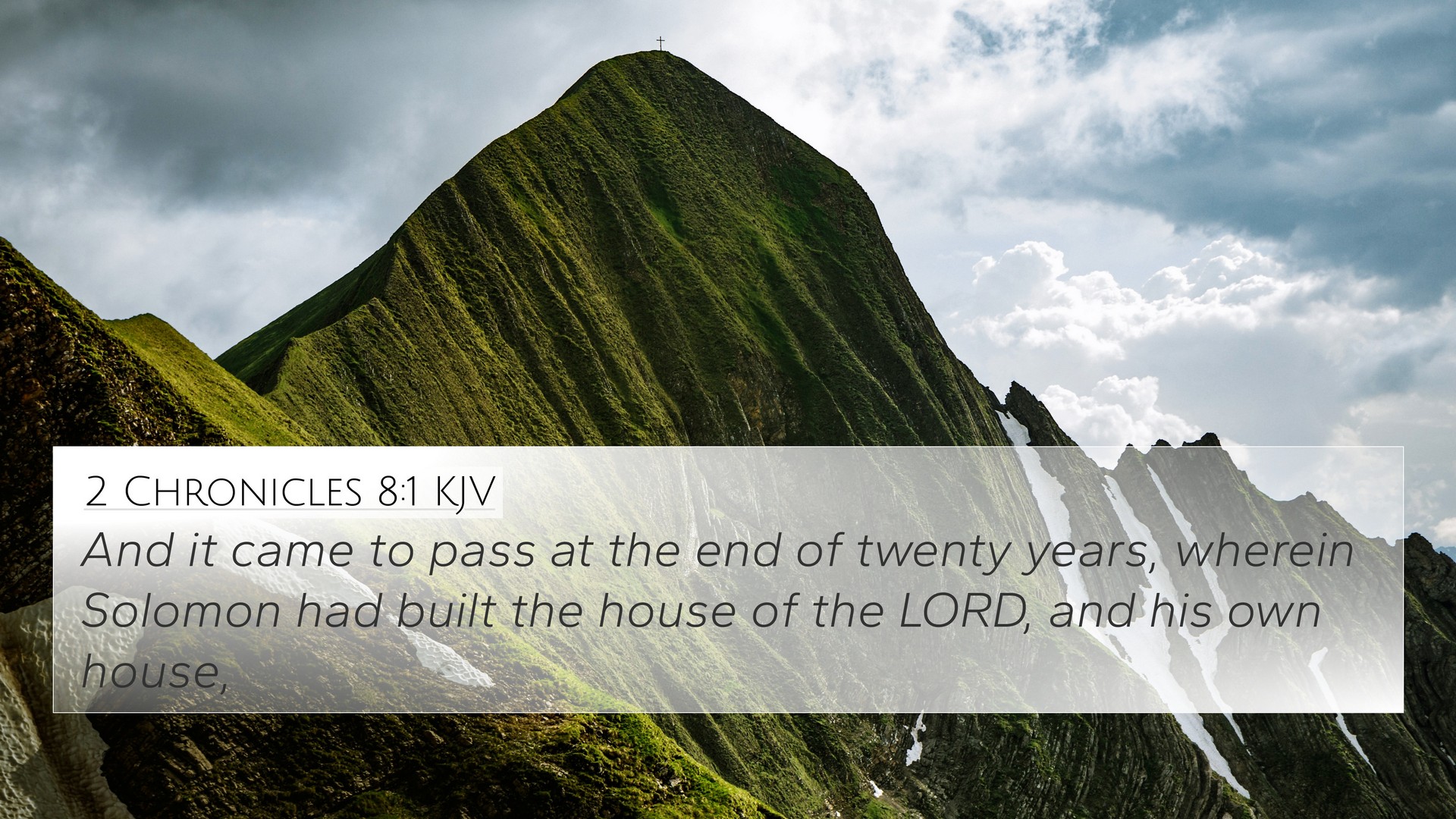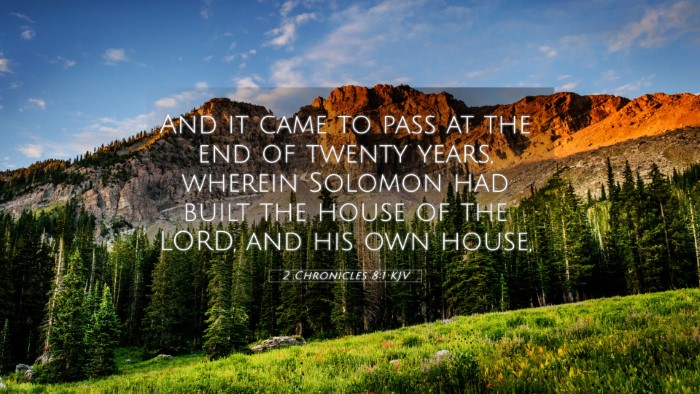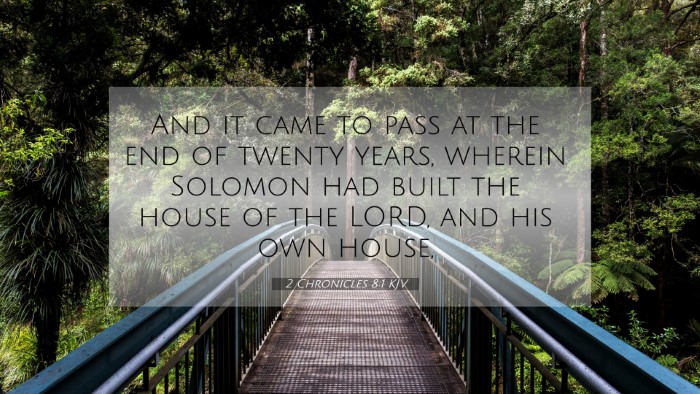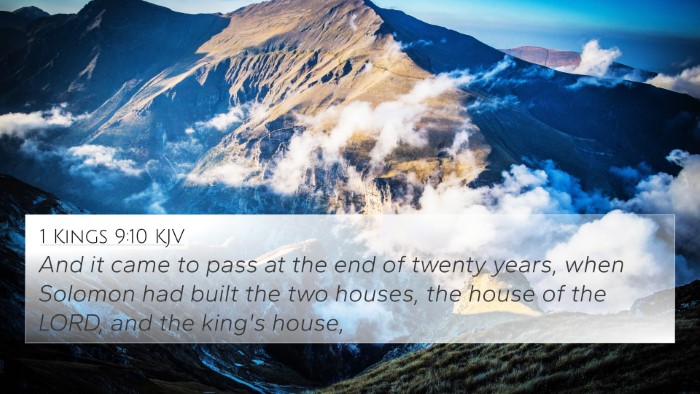2 Chronicles 8:1 - Summary and Commentary
In 2 Chronicles 8:1, the text describes the accomplishments of King Solomon after he had completed building the temple of the Lord. The verse states:
"And it came to pass at the end of twenty years, wherein Solomon had built the house of the Lord, and his own house,"
This verse serves as a pivotal reflection on Solomon’s reign, focusing on the significant undertakings during his rule.
Meaning and Insights from Commentaries
The completion of the temple and Solomon's house signifies a moment of fulfillment of divine promise, where the labor invested by Solomon is recognized as a testament to his devotion and leadership. The completion of the temple, a central place of worship, reflects not only architectural grandeur but a commitment to establishing the worship of Yahweh in Israel.
Key Interpretations
-
Matthew Henry:
Henry emphasizes that the twenty years spent building demonstrate Solomon's dedication to God’s work. The contrast between the temple and his own house indicates that spiritual matters took precedence in Solomon's life, and the completion of both projects demonstrates that he did not neglect his secular responsibilities.
-
Albert Barnes:
Barnes notes that the phrase "it came to pass" marks a significant point in Solomon's reign, highlighting the importance of time in the completion of tasks for the kingdom of God. He also points out the significance of the dual construction projects — the temple being central to Israel’s worship and Solomon’s house representing his royal authority and residence.
-
Adam Clarke:
Clarke elaborates on the logistics and planning required for such monumental tasks, noting the challenges and resources involved in constructing both the temple and the palace. He entwines the historical context, explaining that Solomon's reign was marked by peace and prosperity, allowing for grand projects to flourish.
Cross References for Contextual Understanding
Understanding 2 Chronicles 8:1 can be enhanced by examining related scripture. Here are some key Bible verses that provide connections and deeper context:
- 1 Kings 6:38: Details the timeline for the temple construction, affirming the twenty-year timeframe.
- 1 Kings 7:1: Discusses the building of Solomon's palace and the significance of his royal complex.
- 2 Chronicles 7:11: Illustrates the completion of the temple and the dedication ceremonies that followed.
- Psalms 132:13-14: Celebrates God's choice of Zion as the dwelling place and the importance of the temple.
- 2 Corinthians 5:1: The discussion of earthly and heavenly dwellings draws a parallel to Solomon's desire to build a lasting home for God.
- Isaiah 66:1-2: Reflects on the nature of God's dwelling, hinting at the futility of trying to contain God within a literal structure, akin to the temple.
- Hebrews 9:24: Mentions Christ as a high priest in a greater tabernacle, linking to the significance of the temple's construction.
Thematic Connections in Scripture
The completion of the temple serves as a motif for God's presence among His people. It highlights several recurring biblical themes, such as:
- Divine Guidance: God's providence directing Solomon in his grand projects.
- Worship and Sacrifice: The temple as a place for worship symbolizes the necessity of sacrifice to maintain a relationship with God.
- Legacy and Leadership: The impact of leadership decisions on future generations is poignantly illustrated in Solomon’s endeavors.
Tools for Deepening Understanding
For those looking to dive deeper into the connections between Bible verses, the following resources can be beneficial:
- Bible Concordance: A tool for locating specific verses and themes across the scriptures.
- Bible Cross-Reference Guide: Helps identify related verses, enhancing thematic study.
- Cross-Reference Bible Study Methods: Approaches to analyze how scriptures interconnect.
Enhancing Your Study Through Cross-Referencing
For a more enriched Bible study experience, consider the following:
- Identifying Connections: Seek to connect themes from the Old and New Testaments, like God's covenant with Israel and the salvation through Christ.
- Comparative Studies: Comparing similar themes in the Gospels can reveal deeper insights.
- Sermon Preparation: Utilize cross-references to build a comprehensive understanding of the biblical narrative for preaching and teaching.
As we reflect on 2 Chronicles 8:1, let us recognize the importance of both spiritual and practical aspects of life as demonstrated by Solomon's reign. The verse encourages us to build our lives upon the foundation of faith while responsibly managing our earthly engagements.
Conclusion
This verse encapsulates themes of leadership, responsibility, and divine presence, encouraging believers to understand the significance of their spiritual commitments in relation to their daily lives. By exploring cross-references, one can uncover the extensive dialogue within the Bible that speaks to human experience and God's ongoing relationship with His people.



